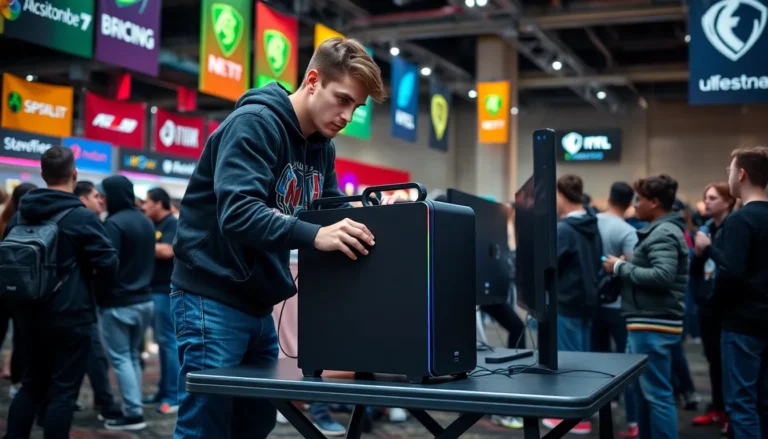Table of Contents
ToggleImagine a home that knows you better than your best friend. Smart new homes are revolutionizing the way people live, making life easier, more efficient, and a little bit cooler. From voice-activated assistants to energy-saving systems, these tech-savvy abodes are like having a personal butler who never runs out of battery.
Overview of Smart New Homes
Smart new homes integrate advanced technology, significantly improving residents’ lives. They provide automation for various tasks, making everyday activities more convenient. Features like smart thermostats and security systems offer energy efficiency and enhanced safety. Homeowners can control these systems remotely, ensuring peace of mind.
Voice-activated assistants facilitate seamless interaction with devices. They allow users to adjust lighting, temperature, or play music with simple commands. Appliances in smart homes often connect to the Internet of Things, enhancing overall functionality. For instance, refrigerators can monitor food supplies and suggest recipes based on available ingredients.
Data indicates that smart homes can increase property value and appeal to potential buyers. A study showed that homes with smart technology sold for up to 5% more than traditional homes. Energy-efficient solutions not only reduce utility bills but also minimize the carbon footprint, aligning with sustainable living trends.
Community developments are increasingly incorporating smart home features. Neighborhoods may offer full automation, from managing security to optimizing energy usage across multiple homes. This trend toward connectivity fosters a greater sense of security and convenience among residents.
Adapting to smart home technology enhances daily living while addressing modern challenges. As these technologies continue to evolve, their integration into new homes becomes more essential. Therefore, embracing smart home solutions can lead to a more efficient, sustainable, and streamlined lifestyle.
Features of Smart New Homes
Smart new homes incorporate a variety of features that enhance comfort, convenience, and functionality. These advancements help create a more efficient living environment.
Automation and Control Systems
Smart home automation systems enable homeowners to manage various aspects of their residence with ease. Automated lighting systems adjust brightness based on the time of day, and smart locks provide secure access remotely. Temperature control becomes simple with programmable thermostats adjusting settings automatically, ensuring optimal comfort. Home security systems alert residents of any unusual activity through real-time notifications. Control systems integrate with mobile devices, allowing seamless management of appliances, lighting, and security from anywhere, adding a layer of convenience.
Energy Efficiency Technologies
Energy efficiency technologies play a crucial role in smart new homes. Smart thermostats track energy consumption patterns and optimize heating and cooling schedules. LED lighting reduces electricity use significantly compared to traditional bulbs. Appliances designed for energy efficiency come equipped with advanced features that minimize water and energy waste. Solar panels integrate easily into smart homes, offering renewable energy sources and lowering utility costs. By combining these technologies, smart homes promote sustainability while saving on monthly expenses, providing economic benefits alongside environmental responsibility.
Benefits of Smart New Homes
Smart new homes offer numerous benefits that significantly improve daily living. These properties incorporate advanced technologies for enhanced safety, convenience, and energy efficiency, creating an elevated living experience.
Enhanced Security Measures
Smart new homes feature cutting-edge security systems designed to protect residents. These systems utilize surveillance cameras, motion detectors, and doorbell cameras to provide real-time alerts for suspicious activities. Homeowners can monitor their properties remotely through smartphones, enhancing security when away. Automated locks add an extra layer of protection, allowing homeowners to grant access to visitors securely. Integration with emergency services ensures prompt responses to potential threats, making smart homes safer than traditional options. Enhanced lighting systems activate based on movement, deterring intruders. These comprehensive security measures promote peace of mind for homeowners.
Improved Comfort and Convenience
Smart new homes deliver unparalleled comfort and convenience through automation. Smart thermostats maintain ideal temperatures by learning occupants’ preferences. Automated lighting adjusts based on the time of day or occupancy, creating a welcoming atmosphere. Voice-activated assistants enable seamless control over various devices with simple commands, reducing daily task burdens. Residents can adjust settings from anywhere, ensuring effortless management of home environments. Appliances connected to the Internet of Things enhance functionality, simplifying meal preparation and management. Smart features like scheduling allow for optimization of chores, making everyday tasks more manageable. Improved comfort and convenience elevate the overall living experience in smart homes.
Challenges and Considerations
Smart new homes present several challenges and considerations that homeowners must weigh before embracing the technology.
Cost Implications
Initial investments into smart home technology often include the purchase and installation of devices and systems. Smart appliances and energy-efficient solutions typically require higher upfront expenditures. Although energy savings generated by smart thermostats and efficient lighting can reduce utility bills, immediate costs may deter some buyers. Long-term financial benefits, like potential increases in property value, can justify these expenditures. Homeowners should evaluate their budget to ensure they can accommodate both the initial and ongoing costs associated with smart homes.
Data Privacy Concerns
Data privacy represents a significant concern in smart new homes. Devices connected to the Internet of Things collect personal information, raising potential vulnerabilities. Cybersecurity risks can manifest through hacking attempts or unauthorized access to sensitive data. Users often don’t realize how much personal information their smart devices transmit. Implementing robust security measures, such as strong passwords and regular software updates, becomes crucial for protecting data. Homeowners must remain vigilant and informed about privacy practices to safeguard their information in an increasingly connected environment.
Future Trends in Smart New Homes
Emerging trends in smart new homes focus on enhanced connectivity and efficiency. Home automation continues to evolve with advanced artificial intelligence capabilities. Smart devices are becoming more intuitive, allowing residents to interact with their homes using natural language. Voice-activated systems streamline tasks, making complex commands easy to execute.
Energy management systems play a critical role in future developments. Smart homes are expected to utilize AI to predict energy consumption patterns, optimizing usage based on real-time data. Energy-efficient appliances automatically adjust operations, significantly lowering utility expenses. Homeowners will benefit from solar panel integration not only for sustainability but also for reduced energy costs.
Another noticeable trend involves improved security features. Facial recognition technology in smart cameras enhances safety by distinguishing between familiar and unfamiliar faces. Residents will receive immediate alerts for unusual activity, ensuring peace of mind. Smart locks now offer keyless entry options that enhance convenience without compromising security.
Integration of augmented reality in home design allows for virtual tours and customized living spaces. Homeowners can visualize furniture arrangements and decor through AR applications before making purchases. This advancement fosters a deeper connection between individuals and their living environments.
Finally, community-focused smart technologies are gaining traction. Neighborhoods equipped with shared resources, such as EV charging stations and communal gardens, encourage sustainability. Residents will enjoy increased interactions and shared responsibilities, fostering a sense of belonging. These trends collectively position smart homes as essential components of future living, prioritizing comfort, security, and environmental responsibility.
Smart new homes represent a significant shift in how people experience daily living. With advanced technology enhancing convenience and efficiency, these homes offer a lifestyle that’s both modern and secure. Automation and connectivity not only improve comfort but also promote energy savings and sustainability. As homeowners weigh the benefits against potential challenges, the future of smart homes looks promising. The integration of AI and innovative security features will continue to shape how residents interact with their living spaces. Embracing smart home technology can lead to a more connected and enjoyable living experience, making it an appealing choice for many.






